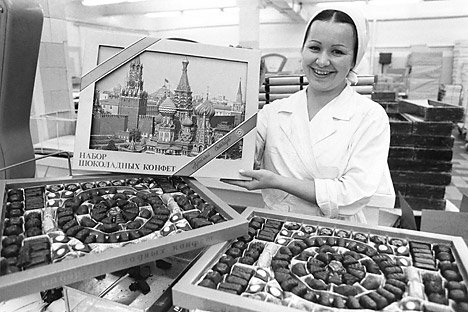
During the Soviet era, foreigners would often buy this type of chocolate as a souvenir. Source: ITAR-TASS
Candy production could be jokingly called Russia’s national idea. No matter what upheaval the country was going through – war, revolution, economic implosion – the production of sweet things never stopped.
In the late 19th century, Russia’s biggest confectionery empire was run by Alexei Abrikosov. Its famous hard candies Rakovyye Sheyki (lobster necks), Gusinyye Lapki (goose feet) and Utinyye Nosiki (duck beaks), were in great demand. Abrikosov also produced a lozenge form of the duck beak and fruit-flavored jelly candies called Lilliput.
Another very popular type of sweets were chocolate-glazed fruits. They were based on a French import and their recipe was a closely held secret. Abrikosov secretly built a factory on the Black Sea to create his chocolate-glazed fruits.
To allay his competitors’ suspicions, Abrikosov explained that his frequent visits to the coast were part of a plan to import Chinese teas. When the factory began operating, stores across the Russian empire began to sell chocolate-glazed fruits from Abrikosov instead of France. Abrikosov was also granted the status of an official purveyor of the imperial court.
The Soviet candy industry borrowed many of Abrikosov’s recipes and technologies. “Goose feet” and “lobster necks” began to be mass produced and sold all over the country. Packaging for them was done on the basis of the same design for the whole of the country.
The original Abrikosov factory became the now-famous Babayev chocolate factory in Moscow, which has produced many well-known chocolate brands. One of these is the chocolate called Vdokhnovenye (inspiration), whose packaging features two ballet dancers striking a beautiful pose with the Bolshoi Theater in the background.
Each chocolate bar inside the package is individually wrapped in foil. During the Soviet era, foreigners would often buy this type of chocolate as a souvenir.
Soviet-era production was unable to meet demand, and that made chocolate a luxury product – not because it was expensive, but because it was too cheap. When it was available, it immediately sold out.
The shortage of candies created a unique type of bribe. Secretaries and personal assistants would be routinely bribed with a chocolate bar to facilitate access to their boss. In various government offices, a box of chocolates could make it easier to get the necessary stamp or signature on a document.
Chocolates, often accompanied by a bottle of cognac, became a typical form of saying thank-you to doctors. A bribe in cash was a criminal offense, whereas a box of chocolates was just a gift.
Alyonka, unwrapped
In the mid-1960s, the government ordered the production of affordable milk chocolate for children. The candy bar that grew out of this order was called Alyonka. The sweet little girl depicted on the wrapper became a best friend to several generations of Russian kids.
Rumors abounded as to the identity of the girl. One theory held that she was the daughter of either the first woman in space, Valentina Tereshkova, or of the first man in space, Yury Gagarin.
The real story goes as follows. Originally the chocolate was supposed to be called Alyonushka (a version of the name Alyona), after a popular Russian folk character, and the picture on the packaging was to be of this fairytale peasant girl. However, it turned out that a similar brand was already being produced by a rival factory.
At that point, the decision was made to change the name of the new chocolate to Alyonka (also a version of Alyona) and to have the competitor’s brand banned for ideological reasons. After all, how could life-affirming Soviet chocolate bars have a picture of a barefoot peasant girl on the package?
In 1965, the newspaper Vechernaya Moskva ran a contest, asking people to submit pictures of their children to be considered for the packaging. The factory received hundreds of photos. In the end, the factory bosses chose the daughter of the factory artist, Alexander Gerinas, Yelena.
Unlike the barefoot peasant Alyonushka, the new Alyonka – with her plump rosy cheeks – was the epitome of Soviet prosperity.
Nearly half a century and hundreds of new chocolate brands later, the cute chubby girl in a headscarf is still staring at consumers from the counter of every market and candy shop across the country.
Click to enlarge the infographics
All rights reserved by Rossiyskaya Gazeta.
Subscribe
to our newsletter!
Get the week's best stories straight to your inbox